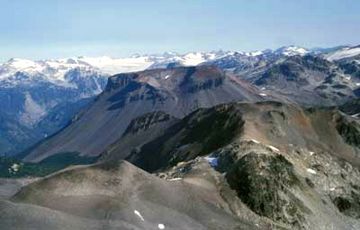Slag Hill facts for kids
Quick facts for kids Slag Hill |
|
|---|---|

An image of Ring Mountain (background) and Slag Hill (foreground)
|
|
| Highest point | |
| Geography | |
| Location | British Columbia, Canada |
| Parent range | Pacific Ranges |
| Geology | |
| Mountain type | Subglacial volcano |
| Volcanic arc/belt | Canadian Cascade Arc Garibaldi Volcanic Belt |
| Last eruption | Holocene |
Slag Hill is a special kind of volcano found in British Columbia, Canada. It's called a subglacial volcano because it formed under a thick sheet of ice. Slag Hill is part of a group of volcanoes known as the Mount Cayley volcanic field.
This volcano is made of a type of volcanic rock that looks a bit like glass. It forms steep, dome-shaped hills and one flat-topped area. These shapes and the way the rock cooled quickly suggest that Slag Hill erupted when it was covered by ice.
Contents
What is Slag Hill?
Slag Hill is a unique geological feature. It's not a tall, cone-shaped volcano like you might imagine. Instead, it's a collection of smaller, dome-shaped hills. These domes are made of a dark, glassy volcanic rock.
The rock has tiny crystals inside it, which makes it look interesting. The way the rock is broken into small, fine pieces also tells scientists a lot. It shows that the lava cooled very quickly, which happens when hot lava meets cold ice or water.
How Slag Hill Formed
Slag Hill was formed over a very long time, during a period called the Pleistocene epoch. This was a time when much of the Earth was covered in huge ice sheets, also known as ice ages.
When volcanoes erupt under ice, the lava cools extremely fast. This rapid cooling creates the glassy rock and unique shapes seen at Slag Hill. Scientists call these "quench features." They are strong clues that the volcano erupted beneath a glacier.
Recent Activity at Slag Hill
Even though Slag Hill formed during the ice ages, it had some more recent activity. A lava flow on its western side shows no signs of having erupted under ice. This means that this particular lava flow happened after the last major ice age ended.
The last ice age finished about 10,000 years ago. So, this lava flow from Slag Hill is less than 10,000 years old. This makes Slag Hill a relatively young volcano in geological terms, even if it's not currently active.
Understanding Subglacial Volcanoes
A subglacial volcano is a volcano that erupts underneath a glacier or ice sheet. These eruptions are very different from those that happen on dry land. When hot lava meets ice, it causes the ice to melt rapidly.
The melted ice can create huge floods, sometimes called jökulhlaups. The pressure from the ice above also affects how the lava flows and cools. This is why subglacial volcanoes often have flat tops or steep, dome-like shapes.
Where is Slag Hill Located?
Slag Hill is located in the beautiful province of British Columbia in Canada. It's part of the Garibaldi Volcanic Belt, which is an area with many volcanoes. This belt is part of a larger chain of volcanoes called the Canadian Cascade Arc.
This region is known for its stunning mountains and volcanic landscapes. Slag Hill is a small but important part of understanding the volcanic history of this area. It helps scientists learn about how volcanoes interact with ice and how the Earth's surface has changed over time.


